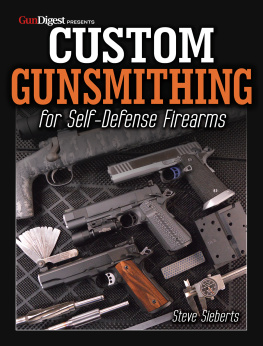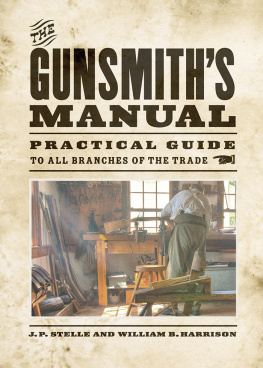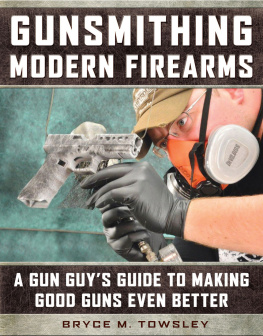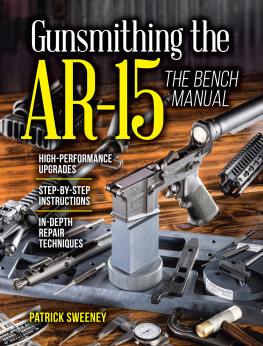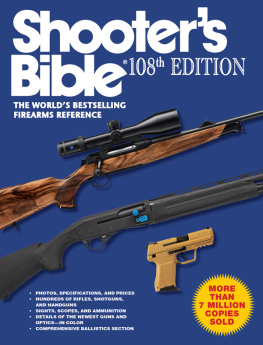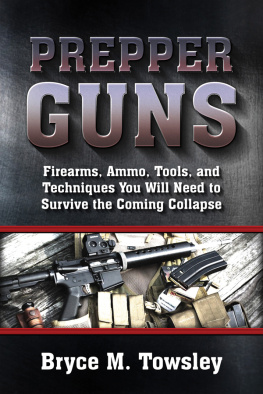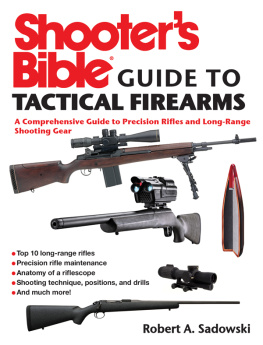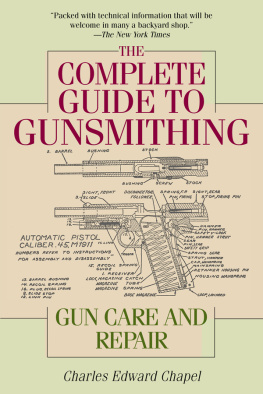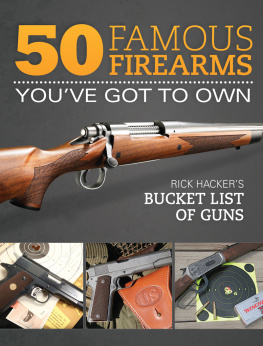Thank you for purchasing this Gun Digest eBook.
Sign up for our newsletter and receive special offers, access to free content, and information on the latest new releases and must-have firearms resources! Plus, receive a coupon code to use on your first purchase from GunDigestStore.com for signing up.
or visit us online to sign up at
http://gundigest.com/ebook-promo
DEDICATION
Anyone who writes a book, never does so in a vacuum, and this one is no exception. Ive had many friends and mentors over the years whove influenced me in my career in professional gunsmithing. Ive always been interested in firearms not only shooting them, but how they worked and I knew at a young age that I wanted to make a career of it. One of the first major influences in my career was Doc Krekle at the Colorado School of Trades Gunsmithing School. Doc taught the Design and Function portion of the course and the wealth of knowledge he brought to the program was immeasurable. Other influencers in my profession were the pistolsmiths on the Army Marksmanship Units pistol team: Sgt. Snow, Sgt. Heilman, and Dalton Graham, who worked on our guns to make sure we had firearms that could deliver National Championship-winning scores, if we could do our part. Make no mistake. Those custom gunsmiths instilled much confidence in the shooters to win every time they stepped up to the line. That is no small contribution, and goes way beyond simply customizing and maintaining the guns.
Another person that heavily influenced me was Bruce Woodford, who taught the Armys National Match Armorers Course at Rock Island Arsenal. Bruce held two Distinguished Badges, one as a rifle competitor, the other in pistol. He also repaired and customized the guns at Camp Perrys National Championships each year. I attended his month-long school, and experienced what building custom match-grade firearms for high-level competitive shooting was all about. Finally, I would also like to dedicate this book to my wife Lori, who has stuck with me through the thick and the thin, and knew early on that my chosen career would not bring fabulous fame nor riches in monetary means, but other treasures like life experiences and great memories. And, last but not least, I dedicate this book to my two children, Kyle and Kelly, who have taught me what is most important in life.
FOREWORD
BY FRANK BROWNELL, CEO, BROWNELLS, INC.
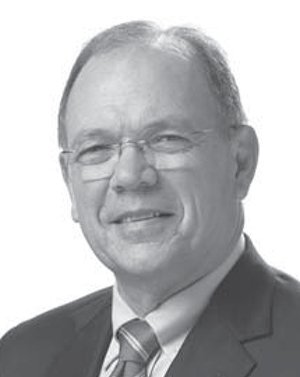
Bob Brownell, my dad, was a gunsmith. There are family stories about him moving my crib around with me in it to make more room for the gunsmithing tools and supplies that shipped to his house in Montezuma, Iowa. As he built the business that would someday become Brownells, he constantly worked on guns, first for his friends and neighbors, and then for people around the country. He particularly loved bluing, and considered it an art form. Even though he closed his own gunsmith shop in 1951 to focus on growing Brownells, he considered himself a gunsmith for the remainder of his life.
Needless to say, Ive always had a soft spot in my heart for gunsmiths. Steve Sieberts is a highly-skilled, knowledgeable gunsmith who graduated from the Colorado School of Trades and worked for the Department of Defense on firearms projects for U.S. Special Operations, and even shot with the Army Pistol Team. He knows a thing or two about guns and gunsmithing, and certainly knows his way around a bench and a lathe.
Anyone involved in gunsmithing the tinkerer or hobbyist, the beginner or the experienced smith, even the competition shooter looking to give himself an extra edge will learn something from this book. There are chapters about general projects any gunsmith must know how to accomplish, as well as more high-level sections about building a truly custom 1911 pistol or Remington 700 rifle. Theres also information about Steves personal story, his journey if you will, in becoming the expert gunsmith he is today.
Thats one of the things I like the most about guns and gunsmithing the stories. Every gun has stories connected to it. Maybe it was the shotgun your grandfather shot his first deer with when he was only a young boy. Perhaps its a rifle that used to belong to a good friend, and you remember the day he watched you make that amazing shot on game. I myself love the memories of squirrel hunting with Dad, me with my .22 and him with the flintlock squirrel rifle he built.
Thats one of the amazing things about gunsmiths. With their knowledge and skill, they keep the guns of yesteryear working just like they did when new. A good gunsmith can equip you to hunt deer with the very same shotgun your grandpa carried. Even better, a good gunsmith can help you pass down that gun to your own child or grandchildren, in fine working order, shooting just as straight and true as it did all those years ago.
And gunsmiths themselves become characters in our stories the smith who cut down the stock to fit your son for his very first trap shoot, or who somehow miraculously fixed your rifle during your once-in-a-lifetime sheep hunt out West, or whose shop became one of your favorite places to visit in the whole world, and who became a good friend, too.
All these things make gunsmiths just a little bit different, maybe even a little more special than other knowledgeable professionals whose services we seek. Gunsmiths work on guns. And while guns certainly are tools, they are so much more than that. Guns are history, both national and family. Guns are fun days spent in the field and at the range. Guns are venison steaks seared perfectly on the grill and shared with friends. Guns might have even saved your life or the life of somebody you love, of which is the primary focus of this book. And finally, guns are the physical proof of the unique freedoms we enjoy here in the United States.
For those of us who count ourselves members of the gun culture, or who might even label ourselves as gun nuts, a gunsmith is the person who keeps our guns running, who makes them fit us well and shoot better. A gunsmith is the person we turn to for knowledge and advice. And a visit to our favorite gunsmiths shop feels more like going to a friends house than patronizing a business. Steve Sieberts is a gunsmith, and a good one at that. Frank Brownell
INTRODUCTION
One of the greatest, most enjoyable aspects in the field of gunsmithing is its history as a profession. Firearms, as we know them today, go back to 13th-Century China. Gunpowder was invented in the 9th Century, and it took 400 years to figure out how to make a tube, fill it with explosive gunpowder and launch the projectile. Rockets had been around since the invention of gunpowder and these were used to scare ones enemies, but the firearm didnt come about until much later. One of the drawbacks of these early firearms was that they tended to explode. This isnt bad if youre firing off rockets with long fuses at your enemy, but if youre holding onto a pipe filled with explosive powder and it goes off in your face, it tended to ruin the day of those early gunmakers. This early Chinese contraption was called the fire lance and was the forerunner to all modern firearms. Also used in those early days were variations of hand cannons, which actually looked like miniature cannons and were held in the hand, hence the name. These hand cannons go back to the Yuan Dynasty in the 13th and 14th Centuries. By the 13th Century, blackpowder and cannons had spread to Europe, most likely over the Silk Road or by invading Mongol warriors. The earliest known example of a firearm in Europe was found in Estonia and dates back to the 1390s.

